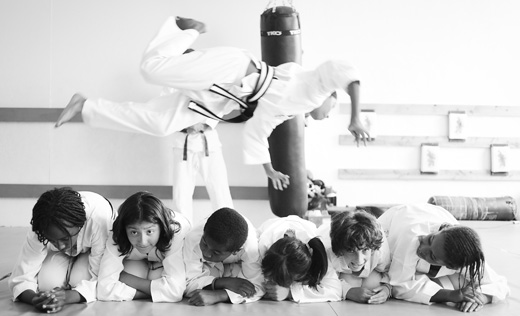By Matt Freeman
 |
“We’re in the business of developing healthy habits of mind and body,” says Dr. Salvatore Sandone, Sensei and CEO of the Zhang Sah Martial Arts. “So we surround our afterschool students with positive role models and work to develop a sense of resilience through social and emotional learning.”
The Philadelphia program puts heavy emphasis on physical exercise and fitness, carving out time for its K-8 students to play at a local park or playground, as well as learning and practicing the martial arts that are the core of the program’s curriculum. Zhang Sah operates at two locations, serving approximately 95 students from eight different schools at each. Children also get a healthy snack every afternoon and spend time doing homework.
The program takes its name from the Korean term for “brave scholar,” and its design embodies a philosophy that combines martial arts with youth development principles. Sandone says the program is structured to value equally the development of mind, body, and character. Instructors are trained to emphasize benevolence, courtesy, humility, integrity, perseverance, self-control, and stewardship.
By using martial arts to inform a broader concept of youth development and wellness, Sandone and his staff correct some of the common misperceptions about the martial arts in the United States and other western countries. For one thing, martial arts study in Zhang Sah is not focused principally on combat.
“It’s often offered up as a remedy to fear, or as an anti-bullying or self-defense approach,” Sandone says. “That’s not really what we’re about as an educational program. We see it as holistic with a physical culture as the centerpiece. And we connect everything through the physical activity.”
As an example, Sandone describes a recent experience with an eight-year-old whose lack of confidence stood in the way of finishing his homework and mastering his multiplication tables.
“He’d faced the same problem—confidence—with one of the early tests for a belt: breaking a one-inch board. We helped him overcome his anxieties around the board, and later used the experience as a metaphor for his homework and multiplication issues. We use success in physical activity as a jumping off point to create and breed success elsewhere.”
Earlier this year, Sandone published a case study on the program, drawing on 2015-16 school year data comparing Zhang Sah students’ wellness and academic outcomes with those of the broader population of Philadelphia public school students.
“Participants in the Zhang Sah program are reported in this study to be achieving at better levels academically and being well,” he found.
According to the data, 68 percent of Zhang Sah students were reading at or above grade level, compared with 38 percent of students in the broader population. Similarly, 94 percent of Zhang Sah students achieved the “Health Fitness Zone,” a standard that accounts for a number of health measures including body mass index. Comparable data were not available for the broader population of Philadelphia students; however, other research found that 41 percent of Philadelphia students were overweight or obese. Finally, Sandone writes that the study “reported significant socio-emotional learning results consistent with research findings with physical fitness supporting mental well-being.”
Zhang Sah does not specifically follow the Healthy Eating and Physical Activity (HEPA) standards created by the National Afterschool Association; however the program is in general alignment. In fact, Sandone served on a 2008 physical activity advisory board that helped develop Healthy Living Guidelines for Out-of-School Time in Philadelphia, an effort that preceded the development of HEPA standards.
Notwithstanding the extensive research base underlying Zhang Sah’s program design, Sandone says that at its heart is a simple conviction, confirmed by research: “If kids are at a healthy weight, they do better across the board. They can achieve that healthy weight many ways; we happen to use martial arts, because of all its other benefits. But other programs might use soccer, running, or something else. There are a hundred ways to do it. It doesn’t require a secret sauce!”
Comments are closed.